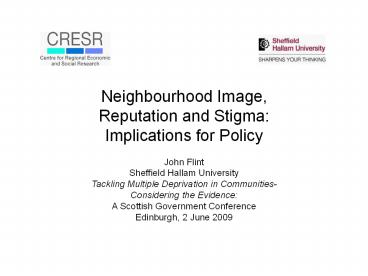Neighbourhood Image, Reputation and Stigma: Implications for Policy - PowerPoint PPT Presentation
1 / 10
Title:
Neighbourhood Image, Reputation and Stigma: Implications for Policy
Description:
Neighbourhood Image, Reputation and Stigma: Implications for Policy John Flint Sheffield Hallam University Tackling Multiple Deprivation in Communities- – PowerPoint PPT presentation
Number of Views:122
Avg rating:3.0/5.0
Title: Neighbourhood Image, Reputation and Stigma: Implications for Policy
1
Neighbourhood Image, Reputation and Stigma
Implications for Policy
- John Flint
- Sheffield Hallam University
- Tackling Multiple Deprivation in Communities-
- Considering the Evidence
- A Scottish Government Conference
- Edinburgh, 2 June 2009
2
Studies of Stigmatisation 1
- 'Every city and town in the UK has
neighbourhoods which have reputations for
problems such as poverty, crime, drug abuse and
physical decay' - (Hastings and Dean, 2000)
3
Studies of Stigmatisation 2
- Suttles (1972) mental geographies or urban
landscapes - Residence as a means of performing identity
(Savage et al., 2005) - The poor are increasingly identified by where
they live (McDowell, 2008)
4
Research Methods
- Hillside/Primalt NDC area in Knowsley,
Merseyside. - Oxgangs in Edinburgh.
- JRF study poverty in face of poverty and poverty
in face of affluence. - 60 interviews (non-representative samples).
- Both relatively deprived Hillside/Primalt more
deprived but less differentiated than its
surroundings.
5
The presence of stigmatisation
- In both areas stigma present
- General and indefinable
- "I know its definitely there."
- Concrete
- "People say to me where do you live and I say X
and they go 'Oh my God, poor you.'" - "I think it did have a bad reputation
becausesome seller was driving up, he said to me
'what's the area like round here, is it still
full of scalleys"
6
But Differentiation and its Implications
- Fraser (1996) over generalisation in the
literature - "People in the areas nearby, they're all the
same." - "Its like you go from one bit of Oxgangs,
- literally you can see the first house in Green
Bank it's a different world."
7
Differentiation Explanations
- Immediacy and visibility of difference
- Sites of interaction
- Wider urban localities
8
Conclusions
- Differentiated image and stigma within and
between neighbourhoods - Uniformity versus gradation and hierarchy
- Linked in complex relationship to perceptions of
neighbourhood problems, neighbourhood attachment
and self-esteem - Non-spatial comparative elements life
history/peers
9
Policy Implications
- Need for more nuanced understanding of stigma,
including 'ordinariness' and 'hierarchy' - Limits of perceptions re neighbourhood problems
and neighbourhood change - Limitations of 'rebranding' exercises
- Difficulties of social mix (schools etc.)
- Sense of ownership equally or more important?
10
References
- Fraser, P. (1996) 'Social and spatial
relationships and the problem inner city
Moss-Side in Manchester', Critical Social Policy,
16, pp. 43- 65. - Hastings, A. and Dean, J. (2000) 'Challenging
Images tackling stigma through estate
regeneration', Policy and Politics, 31(2), pp.
171-184. - McDowell, L. (2008) 'Thinking Through Class and
Gender in the Context of Working Class Studies',
Antipode, pp. 20-30. - Savage, M., Bagnall, G. and Longhurst, B. (2005)
Globalization and belonging, London Sage. - Suttles, G.D. (1972) The Social Construction of
Communities, Chicago University of Chicago Press.































